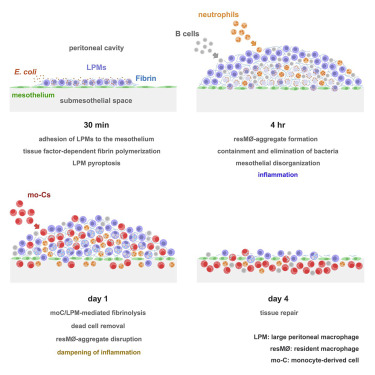Adrián Vega-Pérez, Laura H. Villarrubia, Cristina Godio, Alejandra Gutiérrez-González, Lidia Feo-Lucas, Margarita Ferriz, Natalia Martínez-Puente, Julieta Alcaín, Alfonso Mora, Guadalupe Sabio, María López-Bravo, Carlos Ardavín.
Peritoneal immune cells reside unanchored within the peritoneal fluid in homeostasis. Here, we examined the mechanisms that control bacterial infection in the peritoneum using a mouse model of abdominal sepsis following intraperitoneal Escherichia coli infection.
Whole-mount immunofluorescence and confocal microscopy of the peritoneal wall and omentum revealed that large peritoneal macrophages (LPMs) rapidly cleared bacteria and adhered to the mesothelium, forming multilayered cellular aggregates composed by sequentially recruited LPMs, B1 cells, neutrophils, and monocyte-derived cells (moCs). The formation of resident macrophage aggregates (resMφ-aggregates) required LPMs and thrombin-dependent fibrin polymerization. E. coli infection triggered LPM pyroptosis and release of inflammatory mediators. Resolution of these potentially inflammatory aggregates required LPM-mediated recruitment of moCs, which were essential for fibrinolysis-mediated resMφ-aggregate disaggregation and the prevention of peritoneal overt inflammation.
Thus, resMφ-aggregates provide a physical scaffold that enables the efficient control of peritoneal infection, with implications for antimicrobial immunity in other body cavities, such as the pleural cavity or brain ventricles







